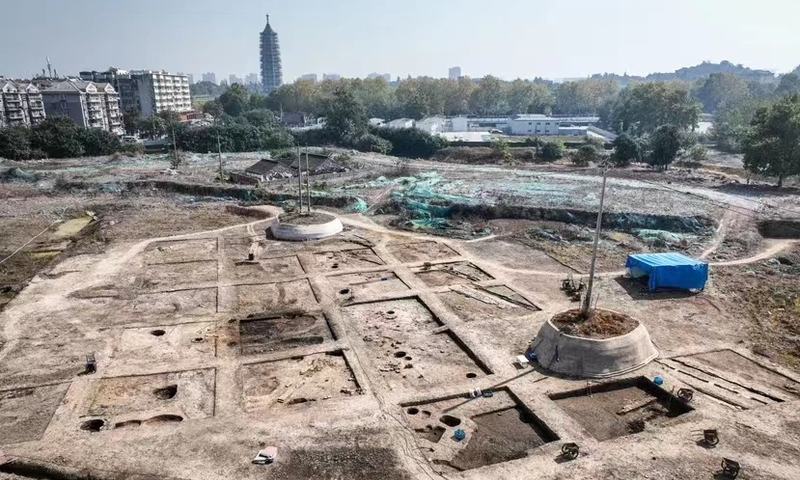Discovery of ancient capital site in Nanjing extends city's history by 600 years

The ruins of an ancient city in Nanjing, East China's Jiangsu Province, have recently been dated to more than 3,000 years ago. The discovery has pushed back the recorded history of Nanjing by 600 years.
The discovered site has been identified as the ancient city of Changgan, which was once been depicted by China's great Tang Dynasty (618-907) literati Li Bai in his poetry collection Ballad of Changgan.
The ancient city reveals circular trenches, wall foundations, water wells and a sacrificial pit for a pig. Consecutive excavations over the past six years have gradually unveiled the architectural layout of the city site.
The circular trenches, in particular, are considered a distinctive feature that signifies the site's past as a city.
"In ancient times, trenches played a crucial role in a city's defense. Therefore, the presence of a defensive system featuring trenches and walls is a significant indication of an ancient city," stated Chen Dahai, the lead archaeologist of the project and an associate professor at the Nanjing Archaeological Research Institute.
The site was discovered to trace back more than 3,000 years, indicating its establishment during the Shang (c. 1600 BC-1046 BC) and Zhou (1046 BC-256 BC) dynasties.
This discovery has extended Nanjing's recorded history by an additional 600 years.
Historian Fang Gang told the Global Times that "the city of Nanjing was traditionally believed to have been founded 2,500 years ago." It is renowned for being the capital of the country for 13 dynasties, including the notable Song (420-479) and Ming (1368-1644) dynasties.
"The dating of the discovery places it around 3,100 years ago. It stands as a remarkable archaeological find in Nanjing in 2023," said Wang Wei, chairman of the Chinese Archaeology Council and also chief expert for China's Project to Trace the Origins of Chinese Civilization.
Archaeologist Lu Zhaojun told the Global Times that the new discovery may also provide "details about ancient Chinese peoples' cultural practices, ritual beliefs as well as their daily lives."
He also emphasized that, in addition to architectural remains, the site should contain artifacts that belonged to people living 3,000 years ago.
Several pieces of pottery with orderly triangle decorations were discovered at the site. These wares are diverse and include ritual vessels such as the ding (a ritual food vessel).
Archaeologist Wang Meng, a specialist in Shang and Zhou dynasty archaeology, told the Global Times that "pottery" was the primary medium for crafting utensils during that era. In addition to the ding, pottery dou and gui were commonly used as cooking utensils, serving as "dishes or containers for liquids, typically wine."
"Those patterns like the triangles decorating the pottery wares are also interesting. They are the results of the exchanges between the cultures of northern and southern China," Wang noted.
Pig bones and charcoal substances were also found at the site, documenting the lives of the Shang and Zhou people.
The ancient city of Changan was discovered within the Nanjing's West Street Ruins and is located close to another historical site called the Porcelain Tower of Nanjing, also known as Dabaoen Temple.
The West Street Ruins cover a total excavation area of 12,000 square meters. More than 10,000 pieces of various archaeological items have been found at the site, including the "ancient city of Changgan."
"I've visited the West Street Ruins once. It is huge and has a lot of interesting discoveries like brick kilns and small alleys that were created by ancient people. You can see the lively city scene back then," Wang noted.
"The new discovery, along with the West Street Ruins' history shows the historical continuity of Chinese culture," Wang emphasized.
Both the West Street Ruins and its Changgan ancient city are now part of the West Street Archaeological Site Park program. The program is dedicated to better exhibiting the historical site to the public through cultural events and activities.